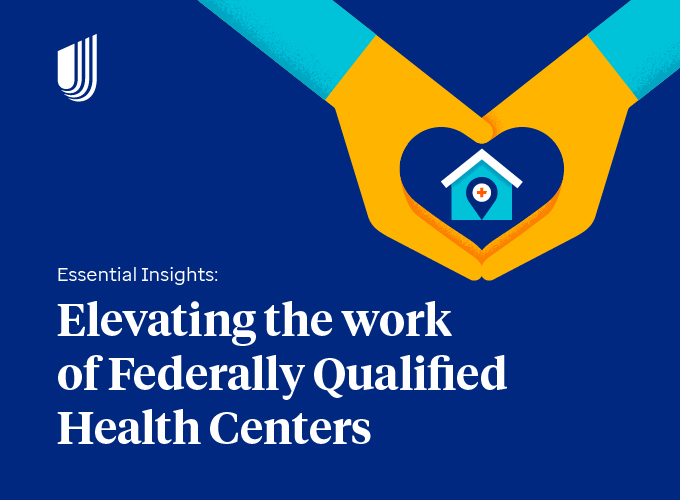Kerianne Guth is Director, Clinical Strategy, UnitedHealthcare Community & State and Tom Tracy is Senior Director, Clinical Strategy, UnitedHealth Group.
Trauma is increasingly recognized as a common experience that connects most people. It’s estimated that 70% of adults in the United States have experienced some type of traumatic event at least once in their life.1 Trauma-informed care provides a framework to understand the individual experiences of people we serve and how their response to trauma impacts their relationship with health care. It’s an essential part of delivering care in medical and social services settings.
Trauma-informed care is rooted in the idea that trauma — an event or circumstance that causes physical, emotional and/or life-threatening harm — is common. The experience of, and response to, trauma is different for everyone and is deeply personal.
A traumatic experience can change the way a person perceives the world. We as individuals, and as an organization dedicated to helping people live healthier lives, must evolve how we consider the widespread experience of trauma in our work. A trauma-informed approach is grounded in a set of four key assumptions (the “Four Rs”), as outlined by Substance Abuse and Mental Health Services Administration (SAMHSA)2. These include:
- Realize that trauma is common
- Recognize the signs and symptoms of what trauma looks like
- Respond by adopting a trauma-informed approach
- Resist re-traumatization of individuals and staff
Empathy is also a crucial component because it removes any blame or judgment and creates a safe space for the individuals we work with, which is essential to the development of authentic healing relationships.
At UnitedHealthcare Community & State, the relationship between physical and emotional health grounds our approach to member care. The impact of trauma and an individual’s ability to “rebound” from a traumatic event (their resiliency) plays a key role in the mind-body connection. Therefore, we have embedded the concepts of trauma-informed care into all Community & State clinical and organizational practices to serve as the backbone of how we approach members. By understanding and implementing trauma-informed care practices, we can help ensure that our members receive the best care and have the best outcomes possible.
Seeing members through a trauma-informed lens
Trauma-informed care and services pivot away from focusing solely on an individual’s conditions and symptoms (asking “What’s wrong with you?”) and toward a strength-based perspective that appreciates what an individual has endured and experienced (asking “What has happened to you?”). Helping professionals approach each member with a level of sensitivity to experiences that create lasting impacts is of utmost importance. SAMHSA offers six key principles of trauma-informed care that apply across direct service, customer service, administrative support, management of people, strategy, and executive leadership: (1) safety; (2) collaboration and mutuality; (3) trustworthiness; (4) peer support; (5) cultural competence; and (6) empowerment and choice.3
These six principles promote dignity, security, trust and respect among those receiving services by creating a relationship and/or environment free from judgment or stigma, by listening to individuals without bias or assumptions, and by communicating openly and respectfully. Operating this way benefits everyone — whether they have been impacted by trauma or not — in understanding the perspectives of those affected by traumatic events and being aware of potential triggers associated with traumatic stress responses. When we recognize that most people have some level of trauma that shapes their perspective, we can pause, reflect and connect more deeply. When we connect more deeply, we are better agents of change.
Research shows that this approach to care results in better engagement rates and better outcomes because it puts the person receiving care in the driver’s seat and connects their care with their personal experience. It moves away from treating a condition to treating the whole person — acknowledging that people have had things happen to them that shape the way they consume and receive services from others, especially health care — and it builds a relationship of trust. As an example, instead of saying “You’re not taking your meds. You must take your meds,” which is loaded with shame and judgment, we change the way we engage to “You know, taking medications is important for your condition, and it seems that you’re having trouble taking your medications consistently. Let’s talk about what’s getting in the way.” The discussion of what the experience of taking the medication has been like for that individual creates safety, trust and mutuality; avoids bias; and promotes choice. Seeing members through a trauma-informed lens allows for understanding that a person’s past experiences, including trauma, affect their current health, behavior and relationships.
Helping members build resilience
What, then, is the reason for one person to experience debilitating impacts of trauma and for another to thrive despite a traumatic event? Resilience. A trauma-informed approach to care recognizes that people can recover from trauma and promotes building resilience as part of that recovery plan. Resilience is the ability to bounce back or rebound from a crisis or stressful situation. It creates a protective shield against traumatic impact, such as prolonged stress and cortisol production, which can lead to negative effects such as high blood pressure, diabetes, immune suppression, headaches, mood disruption and irritability.4
Resilience factors include self-care practices, like exercise and mindfulness; an individual’s support network of family, close friends or community connections; the ability to identify personal strengths; and any activities that give a person positive energy and reduce stress levels.
Resilience is elastic and can be built up, forgotten and revived. Helping professionals can explore a member’s resilience factors and offer ways to strengthen them as protection from the impact of future trauma or adversity. In our care management programs, standard validated resilience scales help us assess and measure a member’s resilience so that we know where we can help build resilience and whether we’ve made an impact.
Operating as a trauma-informed organization
Humanizing member care has a ripple effect on employees. Because trauma is common, employees bring their own personal experiences (including trauma) to the interaction and may experience secondary or vicarious trauma. As we know, titles and licenses do not eliminate the human experience that leaders, clinicians and other health care professionals bring to work every day. Just as trauma-informed care guides us to consider a person’s lifetime of experiences — specifically those that are considered traumatic — fostering a trauma-informed environment means we as professionals also consider our own lifetime of experiences, and we extend that consideration to colleagues, leaders and peers. SAMHSA outlines ten domains associated with implementing a trauma-informed approach for organizations that accounts for employee well-being as well as the well-being of those served. It often requires change at multiple levels within an organization. The ten domains are: (1) Governance and Leadership; (2) Policy; (3) Physical Environment; (4) Engagement and Involvement; (5) Cross Sector Collaboration; (6) Screening, Assessment, Treatment Services; (7) Training and Workforce Development; (8) Progress Monitoring and Quality Assurance; (9) Financing; and (10) Evaluation.5
The evidence of these domains can be seen across UnitedHealthcare Community & State. For example, the trauma-informed care philosophy is woven into the standard new-employee orientation. We start from the front door. When new employees come into the organization, they receive very specific and comprehensive trauma-informed care training (Domain 7) to apply during all interactions with members, regardless of their role.
Our trauma-informed approach is intractably tied to our commitment to cultural humility and organizational values. This means being open and able to learn from the individuals we serve and work with, and to walk alongside them, putting ourselves in the position to receive and listen without bias and judgment. It encourages pausing to recognize that the person we’re talking with knows more about their life and their world than we ever will; the person in front of us had years, decades even, of relationships and experiences before we met them. We cannot discount that reality as we seek to better understand their resilience factors, as well as their opportunities to increase well-being. Genuine empathy in recognizing the strength, fortitude and personal resolve that it took for a person to move through their adversity is an important step in engaging with humility and building trust.
Sources
- https://www.thenationalcouncil.org/wp-content/uploads/2022/08/Trauma-infographic.pdf
- https://store.samhsa.gov/sites/default/files/d7/priv/sma14-4884.pdf
- https://store.samhsa.gov/sites/default/files/d7/priv/sma14-4884.pdf
- https://www.apa.org/topics/stress/body\
- https://store.samhsa.gov/sites/default/files/d7/priv/sma14-4884.pdf











